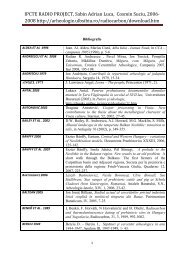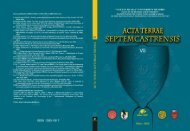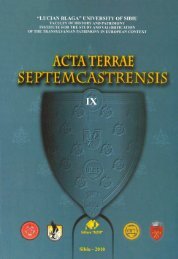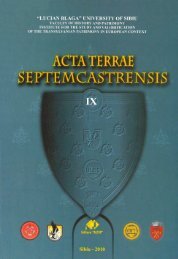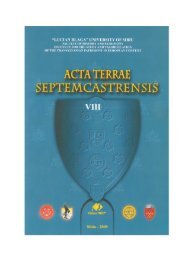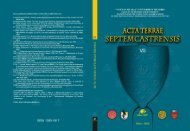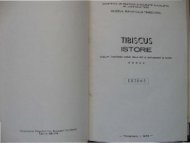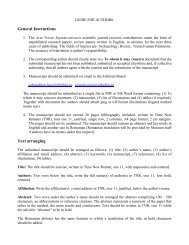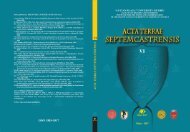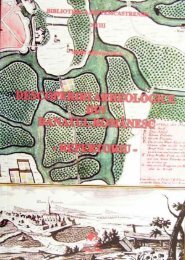Radmila ZotoviÄ, Social and Cultural Aspects of the Burial ...
Radmila ZotoviÄ, Social and Cultural Aspects of the Burial ...
Radmila ZotoviÄ, Social and Cultural Aspects of the Burial ...
Create successful ePaper yourself
Turn your PDF publications into a flip-book with our unique Google optimized e-Paper software.
electronic version at http://arheologie.ulbsibiu.ro/Acta Terrae Septemcastrensis, VI, 1, 2007„Krajčinovići-Slana voda“ are <strong>the</strong> next: 1. <strong>the</strong> both necropolis were also partly destroyed by <strong>the</strong> action <strong>of</strong> <strong>the</strong>earth <strong>and</strong> village's working, 2. in <strong>the</strong> both necropolis were makeing burial <strong>of</strong> <strong>the</strong> man <strong>and</strong> women, 3. inMahrevići dead were burned almost complitly, 4. <strong>the</strong> position <strong>of</strong> <strong>the</strong> heads <strong>and</strong> legs' <strong>and</strong> skelets inMahrevići <strong>and</strong> Posušje show <strong>the</strong> certain <strong>and</strong> similar position like in Krajčinovići i.e. that <strong>the</strong>y were put innecropolis with certain order, <strong>and</strong> 5. <strong>the</strong> archaeological materials found at Mahrevići <strong>and</strong> Posušje are similarwith this from Krajčinovići. According to <strong>the</strong> material found in <strong>the</strong> tumul <strong>and</strong> <strong>the</strong> analogy with <strong>the</strong> materialfrom Mahrevići <strong>and</strong> Vir, <strong>the</strong> necropolis Krajčinovići-Slana voda was dated in <strong>the</strong> middle <strong>of</strong> II century BC.The importance <strong>of</strong> this necropolis is not only in <strong>the</strong> "mix" <strong>of</strong> <strong>the</strong> material <strong>of</strong> three cultural zone, butalso in a few o<strong>the</strong>r points. On <strong>the</strong> first place is <strong>the</strong> fact that on <strong>the</strong> territory <strong>of</strong> <strong>the</strong> western Serbia since <strong>the</strong>end <strong>of</strong> V c. BC until <strong>the</strong> period <strong>of</strong> <strong>the</strong> beginning <strong>of</strong> <strong>the</strong> roman conquest, <strong>the</strong>re were no archaelogicalfinds.The necropolis <strong>of</strong> Krajčinovići-Slana voda was first <strong>of</strong> it, <strong>and</strong> shows that <strong>the</strong> territory <strong>of</strong> <strong>the</strong> westernSerbia was settled in <strong>the</strong> pre-roman period. On <strong>the</strong> second place, <strong>the</strong> form <strong>of</strong> <strong>the</strong> new way <strong>of</strong> <strong>the</strong> burial(without <strong>the</strong> tombs in <strong>the</strong> tumul, but with <strong>the</strong> burial ritual which was made in <strong>the</strong> same time for all deadpeople), shows that this way <strong>of</strong> <strong>the</strong> burial appeared in <strong>the</strong> conditions <strong>of</strong> <strong>the</strong> hurry, in <strong>the</strong> war conditions, butnot in a such hurry that <strong>the</strong>y did not have <strong>the</strong> time for <strong>the</strong> burial ritual without certain order. O<strong>the</strong>rwise, <strong>the</strong>ydid not run <strong>and</strong> <strong>the</strong>y did not leave <strong>the</strong> place <strong>of</strong> living. Also, <strong>the</strong>re were no any traces <strong>of</strong> <strong>the</strong> living on <strong>the</strong>territory <strong>of</strong> <strong>the</strong> western Serbia until <strong>the</strong> very end <strong>of</strong> <strong>the</strong> I <strong>and</strong> <strong>the</strong> beginning <strong>of</strong> II century. Only traces <strong>of</strong>living from <strong>the</strong> first century are more on <strong>the</strong> south, on <strong>the</strong> south-west <strong>of</strong> Serbia <strong>and</strong> <strong>the</strong> north <strong>of</strong> Montenegro,near <strong>the</strong> nowdays towns Prijepolje i Pljevlja, where were found <strong>the</strong> necropolis from <strong>the</strong> I <strong>and</strong> later on to <strong>the</strong>beginning <strong>of</strong> IV century. Why we mention that? Becouse <strong>of</strong> <strong>the</strong> next facts: 1. <strong>the</strong> archaeological materialfrom <strong>the</strong> necropolis from Komini near Pljevlja shows, althought from <strong>the</strong> early time <strong>of</strong> Roman conquest,autochtonic elements <strong>and</strong> <strong>the</strong> similar archaeological material <strong>and</strong> in some cases <strong>the</strong> way <strong>of</strong> burial with <strong>the</strong>far away territory <strong>of</strong> <strong>the</strong> middle part <strong>of</strong> roman province <strong>of</strong> Dalmatia, <strong>the</strong> territory <strong>of</strong> Japodi <strong>and</strong> later onDalmati, 2. <strong>the</strong> all archaeological material including also <strong>the</strong> epigraphic from <strong>the</strong> period from I-IV c. on <strong>the</strong>territory <strong>of</strong> <strong>the</strong> western Serbia <strong>and</strong> north <strong>of</strong> Montenegro shows very long stays <strong>of</strong> tradition <strong>of</strong> older iron age(for example jewlery, pottery, clouths), <strong>and</strong> 3. <strong>the</strong> epigaphic material shows, especially from <strong>the</strong> surounding<strong>of</strong> Pljevlja <strong>and</strong> Prijepolje, appearence <strong>and</strong> existing <strong>of</strong> celtic names. So, on <strong>the</strong> two necropolis aroundPljevlja, socalled necropolis Komini I <strong>and</strong> II, archaeological material shows that <strong>the</strong> pottery from <strong>the</strong> period<strong>of</strong> I c. AD have <strong>the</strong> shapes which point on <strong>the</strong> older tradition <strong>of</strong> halshtat <strong>and</strong> latene period (Cermanović-Kuzmanović 1980, 231, 228-229). Also, on this territory <strong>the</strong>re are appereance <strong>of</strong> <strong>the</strong> celtic pottery, as wellas <strong>the</strong> possible symbiosis <strong>of</strong> celtic <strong>and</strong> ilirian cultural elements on <strong>the</strong> roman grave monuments, if we speakabout <strong>the</strong> style on <strong>the</strong> relief presentation on it (Зотовић 1995, 83-88). Epigraphic material from thisterritory, which we can marked as a part <strong>of</strong> <strong>the</strong> eastern part <strong>of</strong> <strong>the</strong> roman province <strong>of</strong> Dalmatia, shows also<strong>the</strong> analogy with <strong>the</strong> epigraphic material from <strong>the</strong> middle Dalmatian coast, <strong>and</strong> with <strong>the</strong>m made <strong>the</strong> groupwhich Katičić named as <strong>the</strong> unique group <strong>of</strong> <strong>the</strong> south-east name's territory (Katičić 1962;1963). Theappereance <strong>of</strong> <strong>the</strong> grave monuments in <strong>the</strong> shape <strong>of</strong> cube with <strong>the</strong> pyramide, which is characteristic only for<strong>the</strong> eastern part <strong>of</strong> <strong>the</strong> province <strong>of</strong> Dalmatia (to which also belongs with <strong>the</strong> similar cultural <strong>and</strong> ethniccharacteristics <strong>the</strong> territory <strong>of</strong> <strong>the</strong> eastern part <strong>of</strong> nowdays Bosnia <strong>and</strong> Hercegowina), belongs also to <strong>the</strong>inheritance <strong>of</strong> <strong>the</strong> older mediteranian type <strong>of</strong> cipus which get ano<strong>the</strong>r morphological picture in <strong>the</strong> time <strong>of</strong><strong>the</strong> roman rule (Zotović 1995, 30-39; 199).Marić made chronology <strong>of</strong> <strong>the</strong> celtic influence on <strong>the</strong> teritory <strong>of</strong> Bosnia <strong>and</strong> Herzegowina in <strong>the</strong>three phases: 1. from 370.-260. year BC, 2. from 260.-150. year BC <strong>and</strong> 3. from 150.-9. year BC (Marić1963, 65). The picture <strong>of</strong> <strong>the</strong> second phase <strong>of</strong> celtic influence <strong>of</strong> Bosnia <strong>and</strong> Herzegowina by Marić hascharackter <strong>of</strong> <strong>the</strong> stronger influence <strong>of</strong> <strong>the</strong> celtic <strong>and</strong> greek material, <strong>and</strong> at <strong>the</strong> end <strong>of</strong> this phase is <strong>the</strong>beginning <strong>of</strong> <strong>the</strong> roman conquest <strong>of</strong> certain part <strong>of</strong> <strong>the</strong> terittoriy <strong>of</strong> nowdays Bosnia <strong>and</strong> Herzegowina. Thebeginning <strong>of</strong> <strong>the</strong> third phase is <strong>the</strong> beginning <strong>of</strong> <strong>the</strong> stronger connection <strong>and</strong> comunication with <strong>the</strong> Adriaticcoast <strong>and</strong> becouse <strong>of</strong> that appereance <strong>the</strong> new elements in <strong>the</strong> cultural picture <strong>of</strong> Bosnia <strong>and</strong> Herzegowina.If we look on <strong>the</strong> cultural picture <strong>of</strong> necropolis Krajčinovići – Slana voda, this picture is relevant, as well as<strong>the</strong> dateing <strong>of</strong> <strong>the</strong> necropolis, with <strong>the</strong> cultural picture <strong>and</strong> dateing <strong>of</strong> transpassing <strong>the</strong> second into <strong>the</strong> thirdphase <strong>of</strong> Marić chronology <strong>and</strong> cultural relevants for Bosnia <strong>and</strong> Herzegovina. More than that, <strong>the</strong> territory200
electronic version at http://arheologie.ulbsibiu.ro/Acta Terrae Septemcastrensis, VI, 1, 2007<strong>of</strong> western <strong>and</strong> south-western Serbia in archaeological meaning have analogies even in <strong>the</strong> period <strong>of</strong> olderiron age with <strong>the</strong> teritory <strong>of</strong> Bosnia <strong>and</strong> Herzegowina, not with <strong>the</strong> inner side <strong>of</strong> Serbia.The closest analogy with Krajčinovići-Slana voda, Mahrevići <strong>and</strong> Posušje, point on <strong>the</strong> conclusionthat such way <strong>of</strong> <strong>the</strong> burial can appeared as a way <strong>of</strong> <strong>the</strong> burial <strong>of</strong> <strong>the</strong> ethnic groups <strong>of</strong> similar materialculture, as <strong>the</strong> modification <strong>of</strong> <strong>the</strong> older way <strong>of</strong> <strong>the</strong> burial, as <strong>the</strong> psychologically reaction <strong>of</strong> <strong>the</strong> populationon <strong>the</strong> certain unregular conditions, in this case, <strong>the</strong> war. The social level <strong>of</strong> <strong>the</strong> population which madenecropolis Krajčinovići-Slana voda was on <strong>the</strong> level <strong>of</strong> <strong>the</strong> possibility for <strong>the</strong> import <strong>of</strong> helenistic material aslacrimariums, <strong>the</strong> silver jewlery <strong>and</strong> <strong>the</strong> bronze dishes. Although <strong>the</strong>y made h<strong>and</strong>-made pottery in <strong>the</strong>tradition <strong>of</strong> <strong>the</strong> older iron age, <strong>and</strong> also knew for <strong>the</strong> pottery made on wheel.In <strong>the</strong> cultural meaning, <strong>the</strong> ethnic group <strong>of</strong> "Krajčinovići - Slana voda" is on <strong>the</strong> transpassing from<strong>the</strong> 2-nd to <strong>the</strong> 3-rd phase <strong>of</strong> <strong>the</strong> celtic influence in <strong>the</strong> Bosnia <strong>and</strong> Herzegowina (according to Marić), <strong>the</strong>period when <strong>the</strong> influence <strong>of</strong> <strong>the</strong> greek as well as <strong>the</strong> roman culture was remarkable. It is possible that thisethnic group also had <strong>the</strong> contact through <strong>the</strong> valley <strong>of</strong> <strong>the</strong> river Neretva with <strong>the</strong> cities on <strong>the</strong> south-east <strong>of</strong><strong>the</strong> adriatic coast.BIBLIOGRAPHYKatičić, R. 1962. Die Illirischen Personennamen in ihrem sudöstlichen Verbreitungsgebiet, Živa antikaXII,1, p. 95-120; Das mitteldalmatische Namengebiet, Živa antika XII,2, p. 255-292.Marić, Z. 1962. Vir kod Posušja, Glasnik Zemaljskog muzeja u Sarajevu N.S. XVII, p. 63-72.Marić, Z. 1963, Keltski elementi u mladjem željeznom dobu Bosne I Hercegovine, Glasnik Zemaljskogmuzeja XVIII, 63-83.Парович-Пешикан, М. 1998. Замечания по поводу позднего железного века Балкан связи с находкамииз Краǔчиновичеǔ, p. 177-185. In: Gomolava – Cronologie und Stratigraphie der vorgeschichtlichen undantiken Kulturen der Donauniederung und Südosteuropas, Symposium, Ruma 1986.Truhelka, Ć. 1909. Gromila latenske dobe u Mahrevićima kod Čajniča, Glasnik Zemaljskog muzeja uSarajevu XXI, p. 425-442.Zotović, M. 1985. Arheološki I etnički problemi bronzanog i gvozdenog doba zapadne Srbije, Zavičajnimuzej Titovo Užice, Savez Arheoloških društava Jugoslavije, Beograd.Zotović, M. 1987. Problem mladjeg gvozdenog doba u zapadnoj Srbiji u svetlu otkrića u Krajčinovićimakod Priboja. Godišnjak Centra za balkanološka ispitivanja XXV/knj. 23, 51-62.Зотовић, Р. 1995. Римски надгробни споменици источног дела провинције Далмације, Кадињача,Ужице.Zotović, R. 1998. Rückblick auf die Probleme verschiedener kultureller Elemente Südwest-Serbiens in derZeit vor und während der römischen Vorherrschaft, Balcanica XXIX, p. 35-46.Zotović, R. 2002. Population <strong>and</strong> Economy <strong>of</strong> <strong>the</strong> Eastern Part <strong>of</strong> <strong>the</strong> Roman Province <strong>of</strong> Dalmatia, BARInternationa Series 1060, Oxford 2002.Zotović <strong>Radmila</strong>Archaeological Institut BeogradE-mail: rzotovic@eunet.yu201
electronic version at http://arheologie.ulbsibiu.ro/Acta Terrae Septemcastrensis, VI, 1, 2007202
electronic version at http://arheologie.ulbsibiu.ro/Acta Terrae Septemcastrensis, VI, 1, 2007203
electronic version at http://arheologie.ulbsibiu.ro/Acta Terrae Septemcastrensis, VI, 1, 2007204
electronic version at http://arheologie.ulbsibiu.ro/Acta Terrae Septemcastrensis, VI, 1, 2007205



